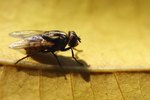Horses experiencing intense itching, lesions, hair loss or thickening of the skin may be infected with mange. Mange is caused by several types of parasitic mites and the treatment for the disease varies based on the type of infection.
If your horse is experiencing symptoms of mange, contact your veterinarian to confirm the diagnosis and determine the best treatment option. Your vet can determine the type of mange infection by inspecting skin scrapings from the affected skin. The mites become visible under a microscope. In some cases, a biopsy is needed to confirm the diagnosis.
Sarcoptic and Psoroptic Mange Treatment
Sarcoptic mange is caused by the Sarcoptes scabiei var equi mite and is the most severe type of mange in horses. This mange usually starts on the head, neck and shoulders but can spread over the body if left untreated. Psoroptic mange, caused by mites of the Psoroptes genus, affects the areas around the base of the tail, under the mane and forelock, under the chin and between the hind legs.
These types of mange are treated with either organophosphate insecticides or lime-sulfur solution. These can be used as a dip or sprayed or sponged onto the horse. In most cases, the treatment must be applied three to four times every 12 to 14 days to successfully get rid of the mites. Oral ivermectin or moxidectin may serve as an alternative.
Tips
Horses with any type of mange may develop a secondary skin infection requiring antibiotic treatment.
Leg Mange Treatment
Chorioptic mange, or leg mange, caused by the Chorioptes equi mite, is most common in heavy horse breeds. This mange usually starts on the lower part of the leg around the fetlock. Without treatment, the condition may become chronic and recede with warm weather and return when weather cools. Topical treatment with organophosphate insecticides or lime-sulfur solution are effective in treating chorioptic mange.
Demodectic Mange Treatment
Demodectic mange is rare in horses; it may occur in horses receiving long-term corticosteroid treatments for other conditions. There is no effective treatment for horses with mange caused by these Demodex-genus mites. Unlike other types of mange, with demodectic mange, horses do not experience extreme itching. While demodectic mange in dogs can be successfully treated with Amitraz, the medication results in colic and death in horses.
Trombiculidiasis and Straw Itch Mite Treatment
Trombiculidiasis is caused by harvest mites or their larvae, chiggers. These mites typically live on plants and infect small rodents, but horses who come into contact with them may be infected. The straw itch mite, or forage mite, typically feeds on straw and grain but may feed on horses who come into contact with the mite in their bedding or feed.
No specific treatment is necessary for these mites. Remove the infested feed or bedding and use a repellent to prevent chiggers and harvest mites. If your horse experiences extreme itching, your vet may prescribe glucocorticoids to reduce the symptoms.
Writer Bio
Maureen Malone started writing in 2008. She writes articles for business promotion and informational articles on various websites. Malone has a Bachelor of Science in technical management with an emphasis in biology from DeVry University.



